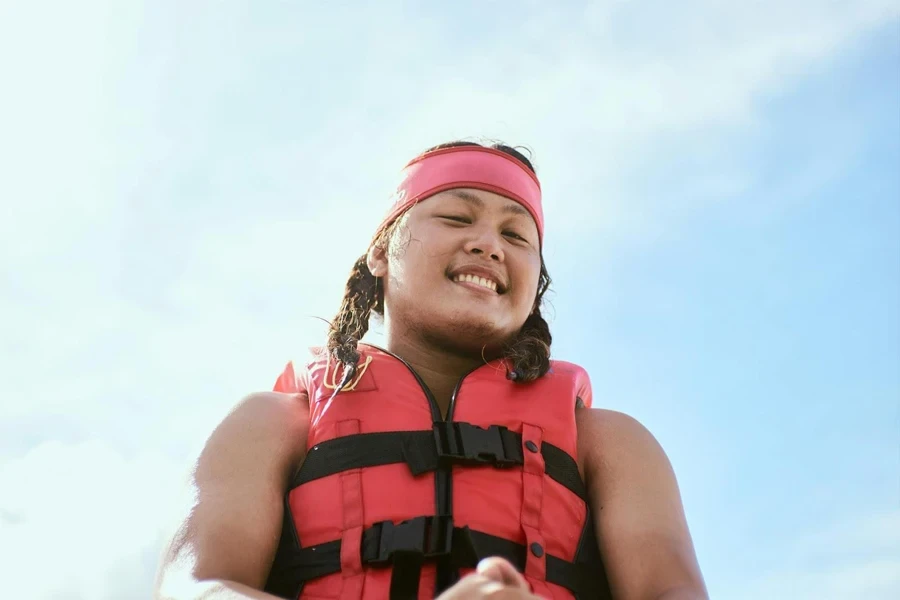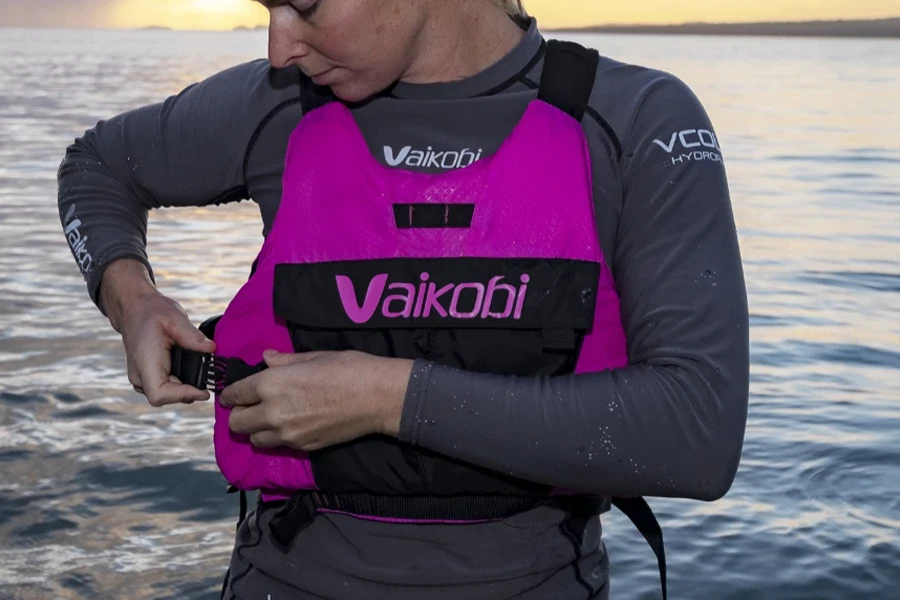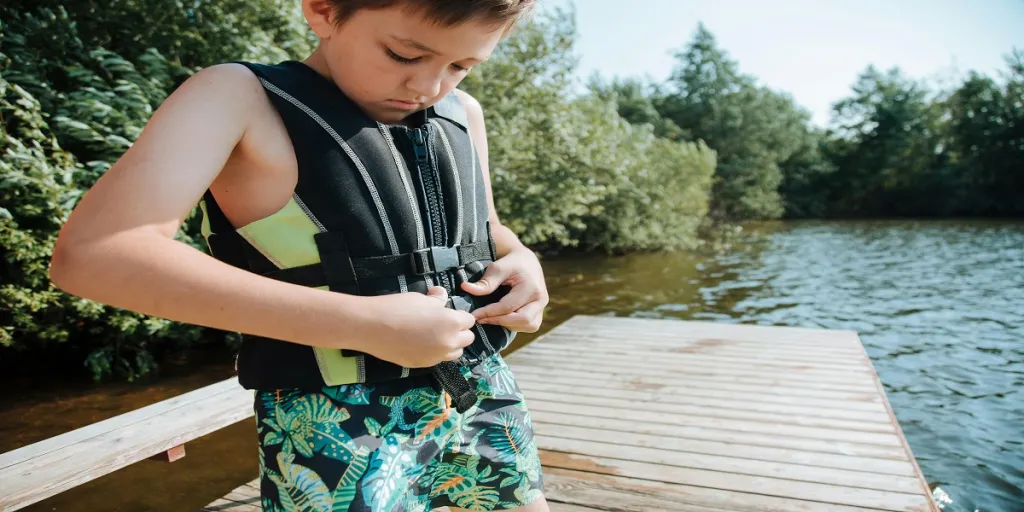Water sports may be fun and exciting, but safety should always come first. Life jackets are one of the top safety accessories consumers should have when enjoying their time in the water. Whether out boating, kayaking, or other water activities, the life jacket consumers have on can make a big difference between a close call and a tragic experience.
Given the importance of life jackets, businesses should consider a number of factors to ensure they select the best options. That’s why this article offers sellers simple tips to ensure they are choosing quality life jackets for their customers in 2024.
Table of Contents
A brief look at the life jacket market
Types of life jackets
4 aspects to look out for when stocking life jackets
Conclusion
A brief look at the life jacket market

Life jackets are an important piece of safety equipment for any water-based activity. Experts valued the global market at US$ 2.5 billion in 2022, expecting it to reach US$ 3.9 billion by 2032 at a 4.5% compound annual growth rate (CAGR). One major factor significantly influencing the market’s growth is the massive surge of people participating in water sports. Also there are growing safety concerns around water sports, which experts say will fuel market growth over the forecast period.
Experts say the European life jacket market accounted for US$ 776.8 million in 2022. However, they expect the regional market to be worth more over the forecast period because Europe is one of the most popular water-based tourist attractions, especially leisure boating. Research also predicts North America will open multiple opportunities in the life jacket market.
Types of life jackets
Standard life jackets
These life jackets are popular for recreational kayakers, canoers, and stand-up paddle boarders. They resemble vests but come equipped with flotation materials. Foam is also the choice these jackets use to create buoyancy.
Pros
- Low maintenance: Standard life jackets don’t need serious care routines. Consumers only need to keep them clean, dry, and away from the sun when not in use.
- Natural buoyant: Standard life jackets can instantly provide flotation—there is no need to activate any mechanisms other than putting them on properly.
- Versatile: These life jackets can keep consumers safe in various water sports, including paddle boarding, kayaking, waterskiing, fishing, and canoeing.
- Pockets: Most standard life jackets come with various pockets for storing snacks, emergency gear, sunscreen, and fishing equipment.
Cons
- Bulky designs: Some consumers consider standard life jackets too bulky and restrictive for paddling, especially for stand-up paddle boarding.
- Low breathability: Standard life jackets can get uncomfortably warm on hot summer days.
Inflatable life jackets
These life jackets are like an upgrade from standard variants. They usually include vests and waist packs with slim profiles that feel incredibly comfortable when uninflated. Nevertheless, manufacturers offer them in two designs: manual and automatic.
Manual inflatable life jackets require pulling a cord to activate the built-in CO2 gas cartridge, which then inflates them for buoyancy. Conversely, automatic designs inflate on their own when submerged in water. Consumers often prefer manual designs for active sports to avoid their life jackets inflating from frequent water splashes.
Pros
- Super comfortable: Inflatable life jackets have slim profiles, making them very comfortable and less likely to restrict paddling motion.
- Cooler designs: Since they cover less of the body, inflatable life jackets remain cool to wear on hotter days.
Cons
- Requires inflation: Inflatable life jackets are not naturally buoyant, which could pose a problem for unconscious or injured wearers.
- Needs maintenance: These life jackets need regular maintenance to work properly. Plus, each inflation will require consumers to change the C02 cartridge.
- Not versatile: Inflatable life jackets can’t handle all water sports or work for everyone. For instance, consumers can’t use them for high-impact activities (like river rafting or whitewater kayaking). Children under the age of 16 or nonswimmers will also avoid these jackets.
Hybrid life jackets

Some life jackets combine the best features of standard and inflatable variants. These best-of-both-worlds products come with natural buoyancy while offering compact, comfortable-to-wear designs. However, hybrid life jackets are often the most expensive type available.
4 aspects to look out for when stocking life jackets
Check for useful features
Life jackets are not just for safety. They should also come with various features to improve the water sports experience. Here are some necessary features life jackets should have before adding them to your inventory:
Pockets
While inflatable life jackets don’t have space for pockets, most standard ones do. So businesses are stocking up on standard life jackets, opting for ones with front pockets as the safest bet. Their size and placement are also important as they determine what gear consumers can stash in them.
Three to five pockets offer the perfect balance of storing essentials without making designs too bulky. Five to eight pockets (including some big ones) are ideal for consumers storing gear like flares or radios.
Color
Life jackets should come in bright colors to remain visible in an emergency. Orange is the king of high-visibility colors, offering excellent contrast against water backgrounds. Fluorescent yellow-green is another great choice for low-light or choppy waters. Other life jackets to prioritize for life jackets include red, fluorescent yellow, and lime green.
Ventilation
If consumers frequently paddle in hot locations, they will want vests that won’t make them feel stuffed and sweaty. So, sellers must offer jackets with built-in vents to allow all that built-up body heat to escape.
Offer the right sizing and fitting
The right sizing and fitting depend on who’s wearing the life jacket. Life jackets come in sizes for adults and children, each with different requirements. Here’s a closer look at each category:
Life jackets for adults
Adults use their chest size to determine their perfect life jacket. Properly sized models should be snug and fit like a glove—all without restricting their movements during activities. Life jackets may also come with adjustable straps for customizable fits. Nevertheless, here are general sizing guidelines for the different adult chest size ranges and their perfect life jacket size:
| Chest size range (inches) | Ideal life jacket size |
| 30 to 34 | XS |
| 35 to 38 | S |
| 39 to 42 | M |
| 43 to 46 | L |
| 47 to 50 | XL |
| 51 to 54 | 2XL |
| 55 to 58 | 3XL |
| 59+ | 4XL |
Life jackets for kids
Unlike adults, weight determines the best size for children. Manufacturers label children’s life jackets as infant, child, and youth, each with different weight ranges. Check the table below for more information.
| Children’s life jacket category | Weight range |
| Infant life jackets | 8 to 30 pounds (3.63 to 13.61 kg) |
| Child life jackets | 30 to 50 pounds (13.61 to 22.68 kg) |
| Youth jackets | 50 to 90 pounds (22.68 to 40.8 kg) |
Check the flotation
This aspect determines how much force (in pounds) consumers need to keep their head and chin afloat. Most adults only require an extra seven to twelve pounds of buoyancy to hold their head above water—and any high-quality life jacket will provide more than that. However, knowing the flotation numbers is a reliable way to compare life jackets to other offers.
But when comparing buoyancy numbers, sellers must consider their target’s weight, lung size, body fat, clothing, and whether the water is calm or rough. Here’s a great example of common yet perfect buoyancy numbers:
- Calm water for adults: 30 pounds is usually sufficient.
- Rough water or activities: 50 pounds is the recommended buoyancy number.
- Offshore or extreme conditions: Such consumers consider 150 pounds and above.
- Children: Choose life jackets with buoyancy ratings matching their weight and age range.
Know the life jacket’s USCG classification
The USCG classification helps ensure consumers have the safest life jacket for their needs. Currently, there are up to five categories determined by the USCG, ranging from Type I to Type V. Keep reading for a closer look at each of them:
Type I
If consumers are heading for remote or turbulent waters, these are the life jackets for them. Their designs are tough enough to hold out in these areas where rescue may take some time. Although these jackets are bulky, they have the highest buoyancy—enough to keep unconscious wearers in face-up positions. Type I life jackets will most likely be on commercial vessels and can come in standard, inflatable, or hybrid designs.
Type II life jackets
The USCG classifies these life jackets for the calmer waters inland. Their designs are basic and less bulky/expensive than Type I variants. However, they are not as comfortable and will only place some consumers face up when unconscious. Type II life jackets come in standard, hybrid, or inflatable designs.
Type III life jackets
These life jackets are the top choice for paddlers, especially for waters with higher chances of quick rescue. They provide the most unrestricted movement and the most comfortable design for continuous wear. Type III life jackets also have standard, inflatable, and hybrid variants.
Type IV
Type IV variants are not life jackets. Instead, they are flotation devices other people can throw at conscious people at high risk of drowning. They also provide backup to life jackets if their buoyancy is not sufficient. Buoyant cushions and life rings are common examples of Type IV flotation devices.
Type V
These life jackets are special-grade and only work for specific activities, which manufacturers specify on their labels. Type V life jackets are available for all water activities and also come in hybrid or inflatable varieties.
Conclusion
Water sports and activities are taking off around the world, but with that comes the importance of staying safe. Sadly, drowning is a big risk, but luckily, life jackets are super helpful in preventing accidents.
This also explains their high level of demand—Google Ads shows they’ve seen 110,000 searches so far in 2024! If retailers are interested in stocking quality life jackets, the tips in this article will help you to pick the best options to help buyers stay safe while enjoying their time in the water.




